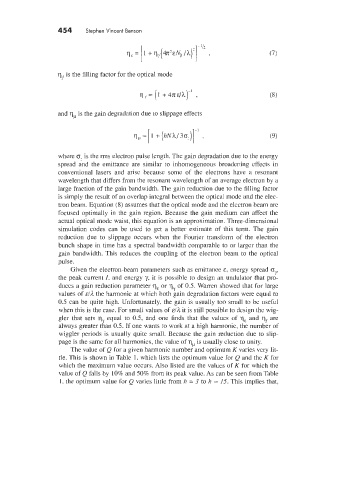Page 494 - Tunable Lasers Handbook
P. 494
454 Stephen Vincent Benson
-1,
qE = [l + 44K'ENp /A)'] - . (7)
qf is the filling factor for the optical mode
and q,u is the gain degradation due to slippage effects
where o- is the rms electron pulse length. The gain degradation due to the energy
spread and the emittance are similar to inhomogeneous broadening effects in
conventional lasers and arise because some of the electrons have a resonant
wavelength that differs from the resonant wavelength of an average electron by a
large fraction of the gain bandwidth. The gain reduction due to the filling factor
is simply the result of an overlap integral between the optical mode and the elec-
tron beam. Equation (8) assumes that the optical mode and the electron beam are
focused optimally in the gain region. Because the gain medium can affect the
actual optical mode waist, this equation is an approximation. Three-dimensional
simulation codes can be used to get a better estimate of this term. The gain
reduction due to slippage occurs tvhen the Fourier transform of the electron
bunch shape in time has a spectral bandwidth comparable to or larger than the
gain bandwidth. This reduces the coupling of the electron beam to the optical
pulse.
Given the electron-beam parameters such as emittance E. energy spread om
I'
the peak current I. and energy y, it is possible to design an undulator that pro-
duces a gain reduction parameter q, or q of 0.5. Warren showed that for large
-f.
values of &/A the harmonic at which both gain degradation factors were equal to
0.5 can be quite high. Unfortunately. the gain is usually too small to be useful
when this is the case. For small values of E/?L it is still possible to design the wig-
gler that sets q, equal to 0.5, and one finds that the values of q, and qf are
always greater than 0.5. If one wants to work at a high harmonic, the number of
wiggler periods is usually quite small. Because the gain reduction due to slip-
page is the same for all harmonics, the value of q, is usually close to unity.
The value of Q for a given harmonic number and optimum K varies very lit-
tle. This is shown in Table 1. which lists the optimum value for Q and the K for
which the maximum value occurs. Also listed are the values of K for which the
value of Q falls by 10% and 50% from its peak value. As can be seen from Table
1. the optimum value for Q vanes little from h = 3 to h = 15. This implies that.

